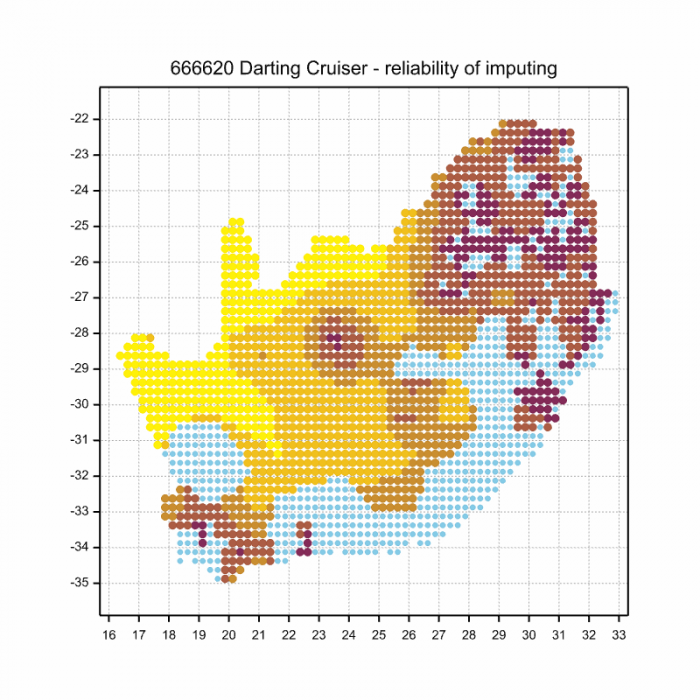View the above photo record (by Gary Brown) in OdonataMAP here.
Find the Darting Cruiser in the FBIS database (Freshwater Biodiversity Information System) here.
Family Macromiidae
Phyllomacromia picta – DARTING CRUISER
Identification
Medium to Large size
Length up to 58mm; Wingspan reaches 81mm.
Sexes are similar in appearance. Females are more robust and lack the yellow/white claspers of the male.
Most resembles other Phyllomacromia species, particularly the Sable Cruiser (Phyllomacromia monoceros). Both species show a bold yellow and black banded thorax, but the Sable Cruiser is larger and has a mostly all-black abdomen.
Readily told apart from the Two-banded Cruiser (Phyllomacromia contumax) which is far larger and has a plain glossy black, unmarked thorax.
Click here for more details on identification of the Darting Cruiser.

Mkuze River, KwaZulu-Natal
Photo by Ryan Tippett

Near Parys, Free State
Photo by Jaco Botes
Habitat
Its breeding habitat is mostly along rivers, often with well wooded areas above the banks. Phyllomacromia picta can also be found at large dams and lakes. They may be seen patrolling a length of river but are far more frequently found away from water. Non-breeding individuals can be found in a wide range of habitats, from forest edge to fynbos and open Karoo scrub far from water.

Photo by Ryan Tippett
Behaviour
This species is seldom seen perched. It is most often found patrolling back and forth along a chosen flight path. It will periodically dart off to chase prey before settling back into its regular route. The flight is smooth and fast. When perched a Darting Cruiser will hang from the underside of a twig or branch. The very long hind legs are probably a hindrance to perching horizontally.
Most active from September to May, possibly year-round at warmer sites. See Phenology below.
Status and Conservation
Phyllomacromia picta is a widespread and common species, although seldom seen in large numbers. It is listed as of Least Concern in the IUCN Red List of Threatened Species. It has a fairly low sensitivity to habitat disturbance.
It is likely under-recorded in the OdonataMap database. This is due to its fast, aerial lifestyle that can make it difficult to photograph.
Distribution
Phyllomacromia picta occurs throughout Southern Africa and its range extends through to Central and East Africa. In South Africa it is most commonly recorded in the North and East.
Below is a map showing the distribution of records for Darting Cruiser in South Africa. Taken from the OdonataMAP database as at February 2020.

The next map below is an imputed map, produced by an interpolation algorithm, which attempts to generate a full distribution map from the partial information in the map above. This map will be improved by the submission of records to the OdonataMAP section of the Virtual Museum.


Ultimately, we will produce a series of maps for all the odonata species in the region. The current algorithm is a new algorithm. The objective is mainly to produce “smoothed” maps that could go into a field guide for odonata. This basic version of the algorithm (as mapped above) does not make use of “explanatory variables” (e.g. altitude, terrain roughness, presence of freshwater — we will be producing maps that take these variables into account soon). Currently, it only makes use of the OdonataMAP records for the species being mapped, as well as all the other records of all other species. The basic maps are “optimistic” and will generally show ranges to be larger than what they probably are.
These maps use the data in the OdonataMAP section of the Virtual Museum, and also the database assembled by the previous JRS funded project, which was led by Professor Michael Samways and Dr KD Dijkstra.

Phenology



